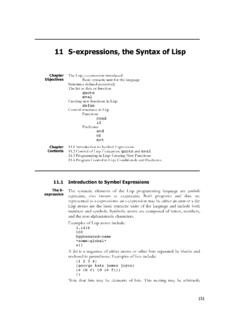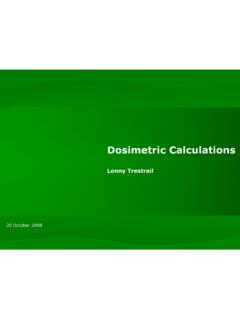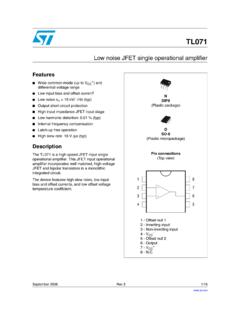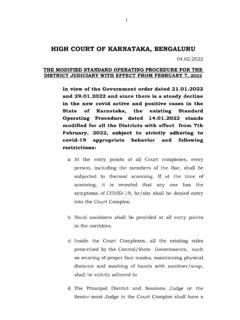Transcription of Fourier Transform Theorems Addition Theorem Shift Theorem ...
1 Fourier Transform Theorems Addition Theorem Shift Theorem Convolution Theorem Similarity Theorem Rayleigh s Theorem Differentiation TheoremAddition TheoremF{f+g}=F+GProof:F{f+g}(s) =Z [f(t) +g(t)]e j2 stdt=Z f(t)e j2 stdt+Z g(t)e j2 stdt=F(s) +G(s) Shift TheoremF{f(t t0)}(s) =e j2 st0F(s)Proof:F{f(t t0)}(s) =Z f(t t0)e j2 stdtMultiplying the byej2 st0e j2 st0=1 yields:F{f(t t0)}(s)=Z f(t t0)e j2 stej2 st0e j2 st0dt=e j2 st0Z f(t t0)e j2 s(t t0) t0anddu=dtyields:F{f(t t0)}(s) =e j2 st0Z f(u)e j2 sudu=e j2 st0F(s). Shift Theorem ExampleF{sin(2 (t+1/4))}(s)=ej2 s4F{sin(2 t)}=ej s2 j2[ (s+1) (s 1)]=j2[ej s2 (s+1) ej s2 (s 1)]=j2[ej ( 1)2 (s+1) ej (+1)2 (s 1)]=j2[ j (s+1) j (s 1)]=12[ (s+1) + (s 1)]=F{cos(2 s)} Shift Theorem (variation)F 1{F(s s0)}(t) =ej2 s0tf(t)Proof:F 1{F(s s0)}(t) =Z F(s s0)ej2 stdsMultiplying the byej2 s0te j2 s0t=1 yields:F 1{F(s s0)}(t)=Z F(s s0)ej2 stej2 s0te j2 s0tds=ej2 s0tZ F(s s0)ej2 (s s0) s0anddu=dsyields:F 1{F(s s0)}(t) =ej2 s0tZ F(u)ej2 utdu=ej2 s0tf(t).
2 Convolution TheoremF{f g}=F GProof:F{f g}(s)=Z [Z f(u)g(t u)du]e j2 stdtChanging the order of integration:F{f g}(s)=Z f(u)[Z g(t u)e j2 stdt]duBy the Shift Theorem , we recognize that[Z g(t u)e j2 stdt]=e j2 suG(s)so thatF{f g}(s) =Z f(u)e j2 suG(s)du=G(s)Z f(u)e j2 sudu=G(s) F(s)Convolution Theorem ExampleThe pulse, , is defined as: (t) ={1 if|t| 120 triangular pulse, , is defined as: (t) ={1 |t|if|t| is straightforward to show that = .Using this fact, we can computeF{ }:F{ }(s) =F{ }(s)=F{ }(s) F{ }(s)=sin( s) s sin( s) s=sin2( s) Theorem (variation)F 1{F G}=f gProof:F 1{F G}(t)=Z [Z F(u)G(s u)du]ej2 stdsChanging the order of integration:F 1{F G}(t)=Z F(u)[Z G(s u)ej2 stds]duBy the Shift Theorem , we recognize that[Z G(s u)ej2 stds]=ej2 tug(t)so thatF 1{F G}(t) =Z F(u)ej2 tug(t)du=g(t)Z F(u)ej2 tudu=g(t) f(t)Similarity TheoremF{f(at)}(s) =1|a|F(sa)Proof:F{f(at)}(s) =Z f(at)e j2 stdtThere are two cases.}}
3 A>0. Multiplying the integral bya/|a|=1and the exponent bya/a=1 yields:F{f(at)}(s) =1|a|Z f(at)e j2 (s/a)atadtWe now make the substitutionu=atanddu=adt:F{f(at)}(s) =1|a|Z f(u)e j2 (s/a)udu=1|a|F(sa)Similarity Theorem (contd.) a<0. Multiplying the integral by|a|/|a|=1and the exponent by |a|/a=1 and usingthe fact thata= |a|yields:F{f(at)}(s) =1|a|Zt= t= f( |a|t)e j2 (s/a)( |a|t)|a|dtWe now make the substitutionu= |a|tanddu= |a|dt:F{f(at)}(s) = 1|a|Zu= u= f(u)e j2 (s/a)udu=1|a|Z f(u)e j2 (s/a)udu=1|a|F(sa)Similarity Theorem ExampleLet s compute,G(s), the Fourier Transform of:g(t) =e t2 know that the Fourier Transform of a Gaus-sian:f(t) =e t2is a Gaussian:F(s) =e also know that :F{f(at)}(s) =1|a|F(sa).
4 We need to writeg(t)in the formf(at):g(t) =f(at) =e (at) :g(t) =e t2/9=e (13 t)2=f(13 t).It follows that:G(s) =3 e (3 s) s TheoremZ |f(t)|2dt=Z |F(s)|2dsProof:Z |f(t)|2dt=Z f (t)f(t)dtSubstituting{F 1{F}} (t)forf (t):=Z [Z F(s)ej2 stds] f(t)dt=Z [Z F (s)e j2 stds]f(t)dtRayleigh s Theorem (contd.)Changing the order of integration:=Zt= t= [Zs= s= F (s)e j2 stds]f(t)dt=Zs= s= F (s)[Zt= t= e j2 stf(t)dt]ds=Z F (s)F(s)ds=Z |F(s)|2dsDifferentiation TheoremF{f }(s) =j2 sF(s)Proof:f=F 1{F}Thereforef(t) =Z F(s)ej2 stdsDifferentiating both sides with respect tot:f (t) =Z j2 sF(s)ej2 stdsorf =F 1{j2 sF(s)}Taking the Fourier Transform of both sides.
5 F{f }(s) =F{F 1{j2 sF(s)}}=j2 sF(s)Differentiation Theorem ExampleF{dsin(2 t)dt}(s)=j2 sF{sin(2 t)}(s)=j2 s j2[ (s+1) (s 1)]= s[ (s+1) (s 1)]= [s (s 1) s (s+1)]= [(+1) (s 1) ( 1) (s+1)]= [ (s 1) + (s+1)]= F{2 cos(2 t)}(s)=F{2 cos(2 t)}(s)












